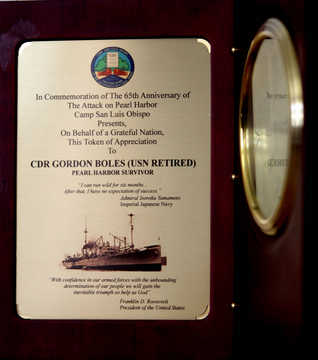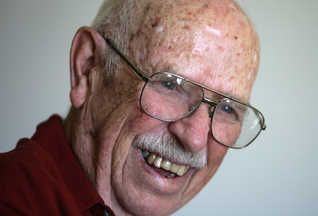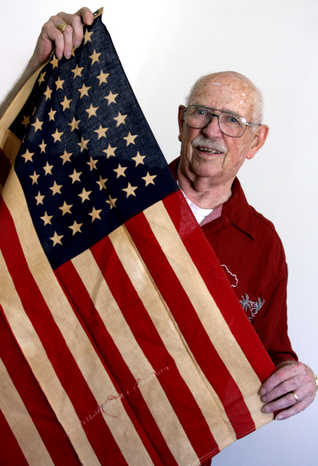BY JENNY SHEARER, Californian staff writer e-mail: jshearer@bakersfield.com |
Sunday, Aug 12 2007 7:55 PM Last Updated: Sunday, Aug 12 2007 11:02 PM
Cmdr. Gordon Boles is the quintessential military man.

Photo by Felix Adamo This commemorative Pearl Harbor plaque/clock sits in Gordon Boles' office.

Photo by Felix Adamo Navy veteran and Pearl Harbor survivor Gordon Boles at his home in southwest Bakersfield.

Photo by Felix Adamo Navy veteran Gordon Boles with his father's American flag, which is approximately 80 years old.
He joined the Navy at 16. That's right, 16. While raising his family, he called his home's walls "the bulkhead," the floor "the deck." He'd sometimes play "Reveille" -- the military's wake-up anthem -- to rouse his three kids. He has a Silver Star and five Purple Hearts. And when the Japanese attacked Pearl Harbor on Dec. 7, 1941, Boles was there. After a 66-year stint away, Boles and his wife of nearly 57 years, Carol, have moved back to Bakersfield. And he's telling his stories. An early start After graduating from Kern County Union High School, Boles briefly studied at what is now San Jose State University. But his grades weren't so good. Without telling his parents, Boles lied about his age, forged his father's signature and enlisted. He picked the Navy because his father retired from it as a chief warrant officer. The recruiter told him to report back in three days, at 0600. "He had to tell me what that was," said Boles, now 83. After boot camp in San Diego, he joined the USS Pyro, an ammunitions ship. It reached Pearl Harbor on Dec. 6, 1941. He remembers a chief telling him that afternoon it was just a matter of time before the Japanese attacked. The next morning, Boles stood on the ship's teakwood deck as bullets from Japanese planes strafed it. "I was absolutely petrified. I couldn't move," he said. White, jagged scars from that day cover Boles' forearms. He was hit by shrapnel 27 times and received the first of five Purple Hearts. Son Mark Boles remembers wanting to know about his father's combat experiences. But his dad wouldn't talk about them until his son was in his 40s. "I wasn't so curious about facts and figures of the war," Mark Boles said. "I was more curious about how he felt." A lot of Gordon Boles' military memorabilia is in storage. But some medals and a framed $1 bill with "HAWAII" stamped on one side are on a bookcase in his study. During WWII, the Treasury Department stamped the money as a precautionary measure, according to a Federal Reserve Bank in San Francisco's Web site. If there had been a Japanese victory, the stamped currency would have prevented the Japanese from confiscating U.S. money, which was negotiable around the world. "Most people have never seen one of those," Boles said. Guadalcanal At 17, while fighting on Guadalcanal, he received a Silver Star and his second Purple Heart. A bullet ripped through his abdomen and took his appendix with it. On the island, the Japanese launched their nightly assaults with primal-sounding hollers. "They would open fire, we would open fire. Nobody knew what they were firing at," Boles said, adding he had a pistol and a single-shot rifle to use in his foxhole. But then he got an automatic rifle to use in his foxhole. He spewed shots all over the beach and as the sun rose, "we found 50 to 60 (Japanese) bodies in front of my foxhole." That same night, he pulled an injured officer down into his sandy trench. After World War II Boles taught military law to young officers in Monterey after the war. That's when he met Carol, a secretary at the school. Although he quickly knew she was the one, wooing her took some effort. "I think it was worth it, me playing hard to get," Carol Boles said. "You'd better believe it," he said, leaning down to kiss her. A large black-and-white framed photo from their wedding day rests on a desk. They have moved 40 times throughout their marriage. He gave the Navy 38 years of service before retiring as a commander in 1979. He led a squadron in the Korean War and a battalion of Seabees in Vietnam. Daughter Shelley Francesconi doesn't remember much of her dad's active military days, but does recall thinking he was the most handsome man in the world when he wore his dress whites to reserve meetings. He instilled a sense of pride in the military in the family, she said. Although his hearing these days isn't good, she said, her dad can "remember the names of shipmates from 60 years ago, exactly where the ship was in the oceans of the world and what they were doing." |


